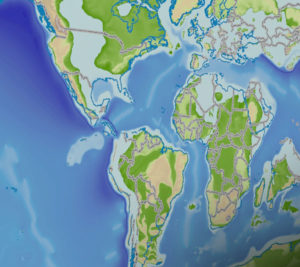Getech Group has released Globe 2019, the latest version of its geoscience knowledge-base that reaches back through three hundred million years to provide invaluable insight to its petroleum exploration customers.
Globe is developed by Getech experts in geophysics, tectonics, palaeogeography, global geology, Earth System Modelling and GIS to help exploration companies better understand petroleum system development, predict geologic risk and assess uncertainty. It is an industry leading geoscience knowledge base, spanning 58 stages through geologic time, that helps explorationists predict the location of Earth’s natural resources quickly and efficiently, using consistent and fully-audited data.

The latest version, Globe 2019, includes new palaeosurface geology, crustal architecture, thermal mapping and lithofacies prediction information. Extending Globe’s rich suite of interactive analysis features is a new animation tool for visualising the movements of the Earth’s plates and geology through time.
Dr Andy Quallington, Head of Geoscience Information Products at Getech, explains some of the detail behind these improvements and the benefits they bring to Globe users; “In Globe 2019, we added further to our unique palaeosurface geology reconstructions, with layers for the Jurassic and Cretaceous stages of the North Atlantic margins. Understanding the nature of the rocks being weathered and eroded allows a detailed evaluation of the types and calibre of sediment that would have been transported and deposited in a basin, providing a better understanding of the presence, character and quality of potential reservoir rocks.”
“Using our Industry leading Gravity and Magnetic database, including our latest Multi-Sat Gravity compilation, we have upgraded Globe’s crustal architecture layers. Introducing a new classification scheme, based on the tectonic origin of the crustal units, we focused firstly on understanding the nature of continental interiors and deformation in orogenic zones. Secondly, we re-evaluated the complex transitional zones between stretched continental and oceanic crust along divergent continental margins. These critical transitional zones not only provide a key element to understanding the tectonic evolution of an area but possess often unique hydrocarbon exploration opportunities which are of particular interest to petroleum exploration.”
“Globe 2019 also comprises new global temperature-at-depth maps. This pioneering work, part of a three year programme, applies a series of integrated workflows including magnetic de-fractal processing of Getech’s global magnetic database, as well as heat flow analysis using physical rock properties and radiogenic heat production estimates. This has allowed us to generate and consistently refine the temperate-at-depth models into a series of global maps, which has been aided by validation from Globe’s customers. These maps provide essential information to users in understanding the thermal profile of a basin, and the impact these temperatures will have had on hydrocarbon maturation.”
To find out more information about Globe, please visit https://getech.com/globe/










